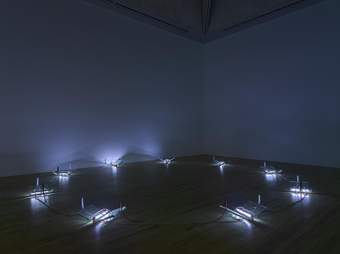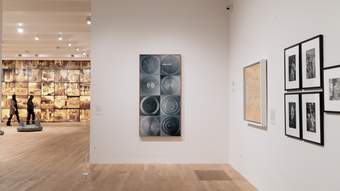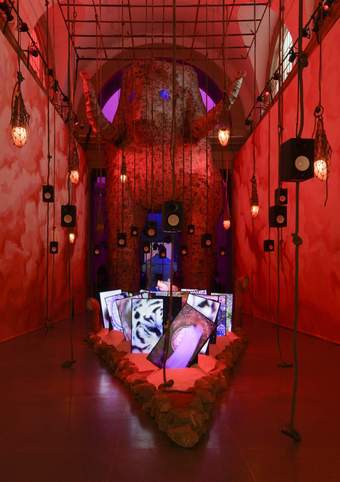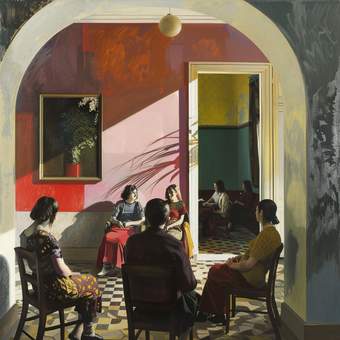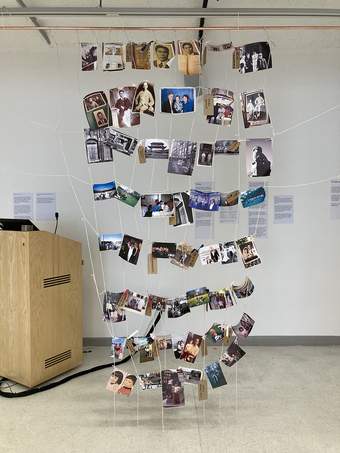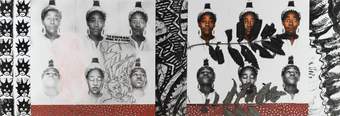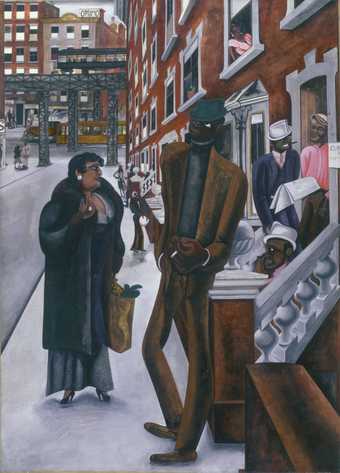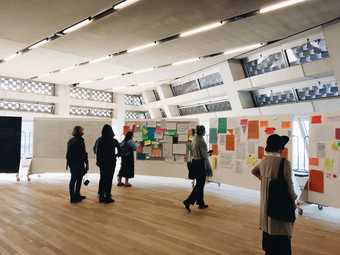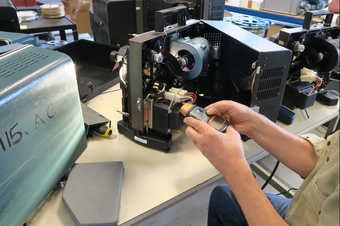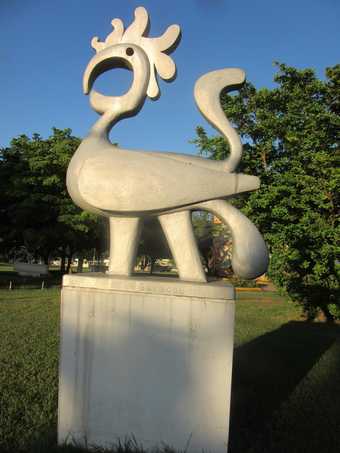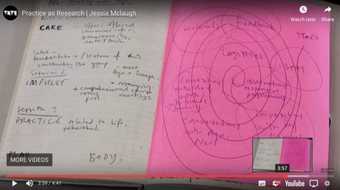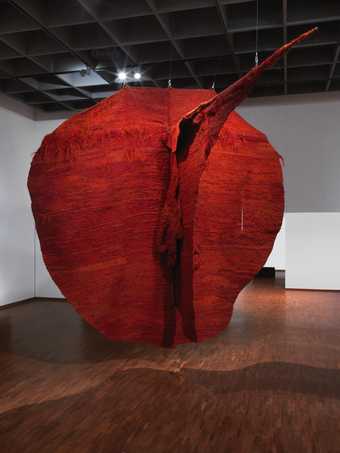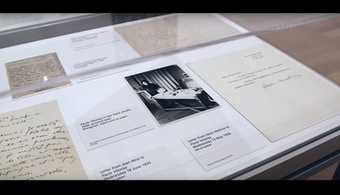Commenced 2019
Roxy Minter
Picturing Whiteness: Raced Representation in the National Collection of British Art, 1700s – Now
Chelsea College of Art and Design, University of the Arts London
Supervised by Professor Paul Goodwin, Chair of Contemporary Art and Urbanism, Chelsea College of Art and Design, University of the Arts London, and Dr Martin Myrone, Lead Curator, Pre-1800 British Art, Tate
Ellen Pavey
Making the Invisible Visible in the Contemporary Art Museum
UCL
Supervised by Dr Theano Moussouri, Institute of Archaeology, UCL, and Professor Pip Laurenson, Head of Collection Care Research, Tate
Caroline Anjali Ritchie
Visionary Mapping in the Work of William Blake
University of York
Supervised by Professor Jon Mee, University of York and Dr Amy Concannon, Curator, British Art 1790–1850, Tate
Maddy Gilliam
How Does a Gallery Education Programme Adapt to Support Teachers with the Arts During a Pandemic?
University of Nottingham
Supervised by Professor Pat Thomson, University of Nottingham and Emily Pringle, Head of Research, Tate
Commenced 2018
Stella Toonen
Challenging Ways of Working: the Impact of Co-creation Projects on Museum Practice
King’s College London
Supervised by Dr Anna Woodham, Lecturer in Arts and Cultural Management, Department of Culture, Media and Creative Industries, King’s College London and Dr Cara Courage, Head of Tate Exchange, Tate
Anya Smirnova
Net Art East: Networks, Art and New Media after 1989
Courtauld Institute of Art
Supervised by Prof. Julian Stallabrass, The Courtauld Institute of Art and Juliet Bingham, Tate
Commenced 2017
Andrew Cummings
Strange Encounters in Contemporary Art from East and Southeast Asia, 1990–Present
Courtauld Institute of Art
Supervised by Dr Wenny Teo, Lecturer in Modern and Contemporary Asian Art, Courtauld Institute of Art and Dr Sook-Kyung Lee, Senior Curator, International Art, Hyundai Tate Research Centre: Transnational
Rhian Addison
Landscape Artists’ Studios in the Age of Exhibitions, London, 1780–1850
University of York
Supervised by Dr Richard Johns, Lecturer in History of Art, University of York and Dr Martin Myrone, Lead Curator (British Art to 1800), Tate
Ambra D'Antone
Translating Collectivity: Surrealism of the Levant
Courtauld Institute of Art
Supervised by Dr Gavin Parkinson, Senior Lecturer in 20th-century European Art, Courtauld Institute of Art, and Dr Matthew Gale, Head of Displays, Tate Modern
Eloise Bennett
Intermediality: The Transformation of Art and Literature in the International Avant-garde, 1945–1975
University of Edinburgh, Edinburgh College of Art
Supervised by Professor Neil Cox, University of Edinburgh and Adrian Glew, Archivist, Tate Britain
Amy Lim
Art Patronage and Court Influence, 1660–1714
University of Oxford
Supervised by Dr Hannah Smith, University of Oxford and Tabitha Barber, Curator (British art to 1800), Tate
Commenced 2016
Janine François
In What Ways Does Art in the Museum Context Provide a Safe Space to Ask Difficult Questions around Culture and Race?
University of Bedfordshire
Supervised by Professor Uvanney Maylor, University of Bedfordshire (Director of Institute for Research in Education) and Alice Walton, Convener, Schools and Teachers at Tate
Inga Fraser
Towards Artists’ Moving Image? Film Art and Paracinema, Britain 1906–1939
Royal College of Art
Supervised by Jeremy Millar, Senior Tutor in Critical Practice at the Royal College of Art, and Dr Andrew Wilson
Commenced 2015
Amina Diab
A Transnational History of Modern Art in Egypt: Flâneuses et flâneurs des deux mondes
University of York
Dr Michael White, Head of Department and Professor of History of Art, University of York and Morad Montazami, previously Adjunct Curator, Tate
Kat Braybrooke
Hacking the Museum, Together: Peer-to-Peer Interactions at Shared Machine Shops in UK Cultural Heritage Institutions
University of Sussex
Supervised by Dr Tim Jordan, Head of University of Sussex School of Media, Film and Music, Dr Caroline Bassett, Director of University of Sussex Humanities Lab, and Dr Rebecca Sinker, Curator, Tate Learning
Karen Di Franco
Embodied Iteration: Materialising the Language of Writing and Performance in Women Artists’ Publishing, 1968–1977
University of Reading
Supervised by Dr Ruth Blacksell, Programme Director in the Department of Typography & Graphic Communication, the University of Reading and Maxine Miller, Library Collections Manager, Tate Britain
Sofia Gurevich
‘Transmission Authority’: Soviet Book Design and the World of Art Circle, 1917–1930
The Courtauld Institute of Art
Supervised by Dr Klara Kemp-Welch, Lecturer in 20th-century Modernism, The Courtauld Institute of Art and Dr Matthew Gale, Head of Displays, Tate Modern
Louisa Hood
Family Learning in Art Galleries
The University of Exeter
Supervised by Professor Tim Coles, Dr Adrian Bailey, University of Exeter and Dr Emily Pringle, Head of Learning Practice and Policy Research, Tate
Eleanor Jones
Beyond Bloomsbury: Queer/Race/Art
King’s College London
Supervised by Dr Clare Barlow, Tate Britain and Professor Mark Turner, King’s College London
Patricia Smithen
The Development and Impact of Artist Acrylic Paints in the United Kingdom
Courtauld Institute of Art
Supervised by Professor Aviva Burnstock, Head of the Department of Conservation and Technology, Courtauld Institute of Art and Dr Bronwyn Ormsby, Senior Conservation Scientist, Tate
Commenced 2014
Tom Ensom
Technical Narratives: Method, Purpose, Use and Value in the Technical Description and Analysis of Software-Based Art
King's College London
Supervised by Dr Mark Hedges, Senior Lecturer in the Department of Digital Humanities, King's College London and Professor Pip Laurenson, Head of Collection Care Research, Tate
Acatia Finbow
The Value and Place of Performance Art Documentation in the Contemporary Art Museum
University of Exeter
Supervised by Professor Gabriella Giannachi, University of Exeter, and Dr Jennifer Mundy, Head of Collection Research, Tate
Amy Harris
Canonising British Sculpture: Sir Francis Chantrey and the Chantrey Bequest
University of York
Supervised by Professor Jason Edwards, University of York, Dr Greg Sullivan, Curator of British Art 1750–1830, Tate, and Dr Caroline Corbeau-Parsons, Assistant Curator of British Art, 1850–1915, Tate
Louisa Lee
Discursive Sites: Text-Based Conceptual Art Practice in Britain
University of York
Supervised by Dr Jo Applin, Senior Lecturer in Modern and Contemporary Art, University of York, and Dr Andrew Wilson, Curator of Modern and Contemporary British Art, Tate
Louisa Penfold
Investigating the Value of Experiential Learning and Play in the Design of Learning Spaces for Young Children at Tate
University of Nottingham
Supervised by Dr Emily Pringle, Head of Learning Practice, Research and Policy, Tate, and Professor Pat Thomson, School of Education, University of Nottingham
Alison Wright
British Sporting and Animal Art, 1760–1840. A Critical History of its Production, Reception, Collection and Display
University of East Anglia
Supervised by Dr Sarah Monks, University of East Anglia, and Dr Martin Myrone, Lead Curator Pre-1800 British Art, Tate Britain
Commenced 2013
Hazel Atashroo
Creative Communities in Art and Design in the 1980s
University of Southampton
Supervised by Professor Jonathan Harris, University of Southampton, and Lindsey Fryer, Head of Learning, Tate Liverpool
Helena Bonett
Barbara Hepworth: Practice, Interpretation, Legacy
Royal College of Art
Supervised by Dr Claire Pajaczkowska, Senior Research Tutor, School of Material, Royal College of Art, Dr Victoria Walsh, Head of Programme, Curating Contemporary Art, Royal College of Art, and Dr Chris Stephens, Curator (Modern British Art) & Head of Displays, Tate Britain
Amy Concannon
The ‘Unnatural’ Landscape: Visualisation of the Urban Scene 1800–50
University of Nottingham
Supervised by Nicholas Alfrey, Associate Professor in Art History, University of Nottingham, Steven Daniels, Professor of Cultural Geography, University of Nottingham, Dr David Blayney Brown, Curator (British Art 1790–1850), Tate
James Finch
David Sylvester: Art Writings
University of Kent
Supervised by Professor Martin Hammer, University of Kent, and Dr Jennifer Mundy, Head of Collection Research, Tate
Judith Lee
Modern British Oils: History, Formulation and Use
Courtauld Institute of Art
Supervised by Professor Aviva Burnstock, Head of the Department of Conservation and Technology, Courtauld Institute of Art, and Dr Bronwyn Ormsby, Senior Conservation Scientist, Tate
Nicola Sim
Circuit: Investigating Partnerships between Visual Arts and Youth Organisations
University of Nottingham
Supervised by Dr Emily Pringle, Head of Learning Practice, Research and Policy, Tate, and Professor Pat Thomson, School of Education, University of Nottingham
Commenced 2012
Lina Džuverović
Hybrid Practices: Interdisciplinarity and Pop Art Sensibilities in Yugoslav Art in 1960s and 1970s
Royal College of Art
David Crowley, Professor and Head of Programme Critical Writing in Art & Design, Royal College of Art and Jessica Morgan, Curator, Tate
Oliver Peterson Gilbert
The Sites of Cultural Production and Impact of British Art and Design Communities Associated with Pop 1956–1974
University of Southampton
Supervised by Professor Jonathan Harris, University of Southampton, and Lindsey Fryer, Head of Learning, Tate Liverpool
Sofia Gotti
Counterculture in Pop: South American Art in the 1960s
University of the Arts, London
Dr Michael Asbury, University of the Arts, London, and Jessica Morgan, Curator, Tate
Commenced 2011
Thomas Ardill
Between God, Art and Mammon: Religious Painting as Public Spectacle in Britain c.1800–50
Courtauld Institute of Art
Supervised by David Solkin, Professor of the History of Art, Courtauld Institute of Art, and Dr Martin Myrone, Lead Curator Pre-1800 British Art, Tate Britain
Ayesha Ghanchi
A Critical Analysis of Artists’ Engagement with Learning Programmes at Tate 1970–2010, as Documented in Tate’s Education Archive
Goldsmiths, University of London
Supervised by Emily Pringle, Tate Learning, and Dennis Atkinson, Professor of Art in Education and Head of the Research Centre for Arts in Learning at the Department of Educational Studies at Goldsmiths, University of London
Isabella Maidment
Performance, Action, Event
University College London
Supervised by Briony Fer, Professor of Art History, University College London, and Catherine Wood, Curator of Contemporary Art and Performance, Tate
Rachel Rose Smith
The International Context of the Art of St Ives 1948–60
University of York
Supervised by Dr Michael White, Senior Lecturer in History of Art, University of York, and Dr Chris Stephens, Head of Displays, Tate Britain
Ioanna Zouli
Digital Tate: The Uses of Video in the Construction of Audiences
London South Bank University
Supervised by Andrew Dewdney, Professor of Educational Development, London South Bank University, Victoria Walsh, Tate Research, and Jane Burton, Head of Content and Creative Director, Tate
Commenced 2010
Wendy Asquith
Haiti in Art: Creating and Curating in the Black Atlantic
University of Liverpool
Supervised by Dr Dmitri van den Bersselaar and Professor Charles Forsdick, University of Liverpool, and Lindsey Fryer, Head of Learning, Tate Liverpool
Hayley Flynn
Landscape in Blake: Visionary Topographies
University of Nottingham
Supervised by Professor Nicholas Alfrey, University of Nottingham, and Dr David Blayney Brown, Curator, Tate Britain
Sabina Gill
Fotografia Polska: Adventures in Polish Photography since the 1960s
University of Essex
Supervised by Professor Margaret Iversen, University of Essex, and Dr Simon Baker, Curator (Photography and International Art), Tate
Cora Gilroy-Ware
The Classical Nude in Romantic Britain
University of York
Supervised by Professor Elizabeth Prettejohn, University of York, and Dr Martin Myrone, Curator, Tate Britain
Robert Sutton
Henry Moore: Sculpture and Media in Twentieth-Century Britain
University of York
Supervised by Dr Michael White, University of York, and Professor Anne M. Wagner, The Henry Moore Foundation Research Curator, Tate
Stephen Vainker
Experiences and Engagement: An Investigation of Young Persons’ Visits to ARTIST ROOMS on Tour
University of Exeter
Supervised by Dr Adrian Bailey, University of Exeter, and Dr Emily Pringle, Head of Learning Practice, Research and Policy, Tate
Victoria Young
Art Museum Attendance and the Public Realm: The Agency of Visitor Information in Tate’s Organisational Practices of Making the Art Museum’s Audience
London South Bank University
Supervised by Professor Andrew Dewdney, London South Bank University, and Dr Victoria Walsh, Head of Adult Programmes, Tate Britain
Commenced 2009
Elena Crippa
When Art Schools Went Conceptual: The Development of Discursive Pedagogies and Practices in British Art Higher Education in the 1960s
The London Consortium
Supervised by Professor Nigel Llewellyn, Head of Research, Tate
Caroline Good
The Making of a National Art History: British Writers on Art and the Narratives of Nation 1660–1735
University of York
Supervised by Professor Mark Hallett, University of York, and Professor Nigel Llewellyn, Head of Research, Tate
Marion Martin
Tragic Hope – Sentiment and Critique in the Art of J.M.W. Turner
University of Leicester
Supervised by Dr Matthew Potter, University of Leicester, and Dr David Blayney Brown, Curator (18th and 19th century British Art), Tate
Alex Massouras
The Emergence of the Emerging Artist in London, 1960–2010
The London Consortium
Supervised by Professor Nigel Llewellyn, Head of Research, Tate
Peter Moore
British Graphic Art, 1660-1735: An Atlantic Perspective
University of York
Supervised by Professor Mark Hallett, University of York, and Dr Martin Myrone, Lead Curator, pre 1800 British Art, Tate
Stephanie Straine
Drawing Strategies in the 1960s and 1970s
University College London
Supervised by Professor Briony Fer, University College London, and Dr Mark Godfrey, Curator (Contemporary Art), Tate
Lynn Wray
Art, Process and Propaganda on the Political Left
Liverpool John Moores University
Supervised by Dr Alison Rowley, Professor Juan Cruz, Liverpool John Moores University, and Dr Christoph Grunenberg, Director, Tate Liverpool
Commenced 2008
Susannah Gilbert
Latin American Art in an International Context
University of Essex
Supervised by Professor Dawn Ades, University of Essex, and Tanya Barson, Curator, Tate
Commenced 2007
Bryony Bery
Replicas and Reconstructions: Case Studies in Twentieth-Century Art
University College London
Supervised by Professor Briony Fer, University College London, and Dr Matthew Gale, Head of Displays, Tate Modern
Corinna Dean
Establishing Tate Modern Cultural Quarter
London School of Economics
Supervised by Professor Robert Tavernor, London School of Economics, and Donald Hyslop, Head of Regeneration and Community Partnerships, Tate
Alex Hodby
Tate Modern and the Expansion of ‘New Institutionalism': New Developments in Art and Public Programming Practices
Goldsmiths, University of London
Supervised by Bernadette Buckley, Goldsmiths, University of London, and Dr Marko Daniel, Curator (Public Programmes), Tate
Commenced 2006
Caroline Donnellan
Establishing Tate Modern: Vision and Patronage
London School of Economics
Supervised by Professor Robert Tavernor, London School of Economics, and Dr Victoria Walsh, Head of Adult Programmes, Tate
Ali MacGilp
The London Art Market and the Formation of a National Collection at Tate 1926–1950
University of Reading
Supervised by Dr Anna Gruetzner Robins, University of Reading, and Robert Upstone, Curator (Modern British Art), Tate
Seph Rodney
Two Rooms: Locating the Meeting Place of the Visitor and the Museum
Birkbeck, University of London
Supervised by Dr Gordon Fyfe, Birkbeck, University of London, and Dr Marko Daniel, Curator (Public Programmes), Tate Modern
Commenced 2005
Rob Knifton
Centre of the Creative Universe: Liverpool and the Avant-Garde
University of Liverpool
Supervised by Professor Jim Aulich, University of Liverpool, and Dr Christoph Grunenberg, Tate
Philippa Simpson
The London Art Market, 1790–1815: The New Exhibition Culture and the Staging of the British School
Courtauld Institute of Art
Supervised by Professor David Solkin, Courtauld Institute of Art, and Martin Myrone, Curator (18th & 19th century British Art), Tate




